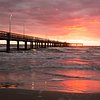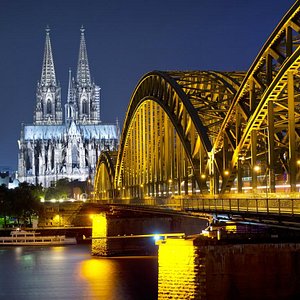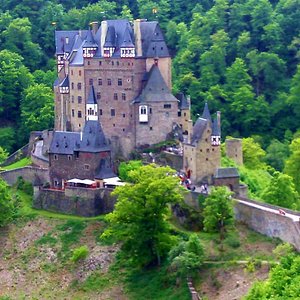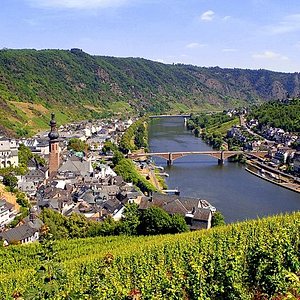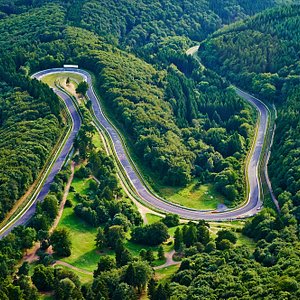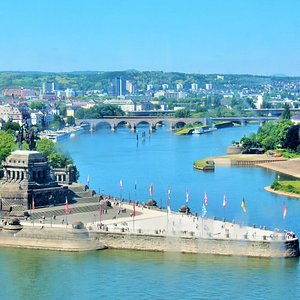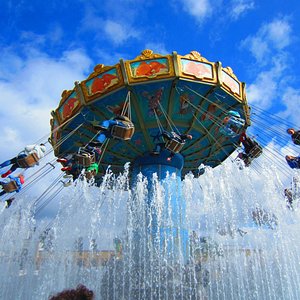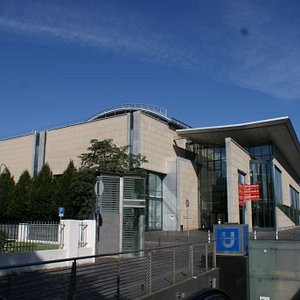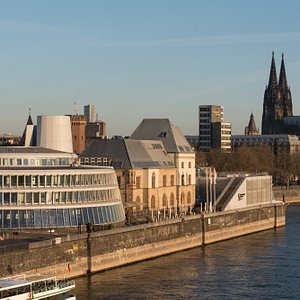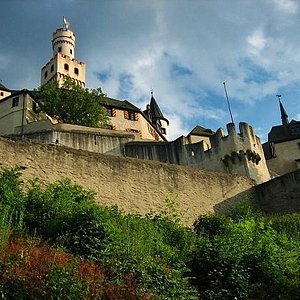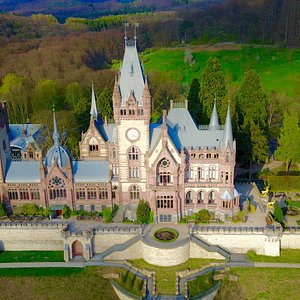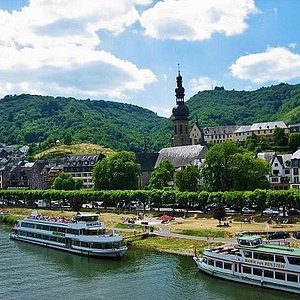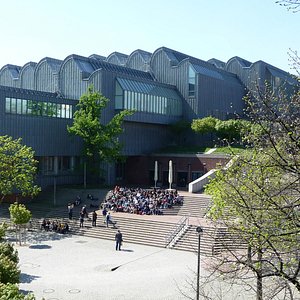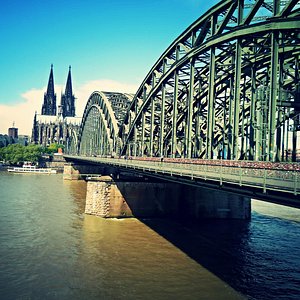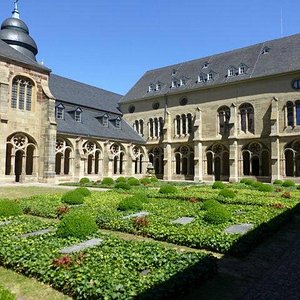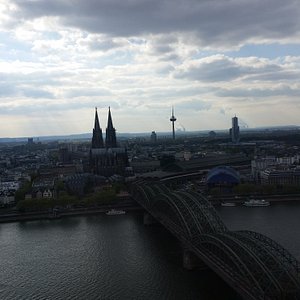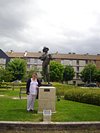Things to Do in Mayen, Germany - Mayen Attractions
Things to Do in Mayen
Tours near Mayen
Book these experiences to see what the area has to offer.
- Audio Guidesfromper adult$15
- Historical Toursfromper group (up to 15)$343
- Historical Toursfromper group (up to 15)$342
- fromper group (up to 6)$34
- Historical Toursfromper group (up to 15)$419
- Historical Toursfromper adult (price varies by group size)$32
- Historical Toursfromper adult$22
- Food & Drinkfromper adult$22
- Food & Drinkfromper adult$33
- Bike Toursfromper adult$44
Other Top Attractions around Mayen
What travelers are saying
- 3wilddogsWestminster, CO139 contributionsWe didn't have time to go through the whole Eifel museum at the Genoveva Castle but it looked very well put together and would be educational for kids. I didn't go up the tower, but you would have a great view of the city if you did.Written May 1, 2024This review is the subjective opinion of a Tripadvisor member and not of Tripadvisor LLC. Tripadvisor performs checks on reviews.
- Niicole16Almere, The Netherlands49 contributionsGreat! Thoroughly enjoyed our 15.6 km (or so) walk. The roads are well kept, the indicators are always there when you need them and there are plenty of places with benches to take a break along the way. The views are amazing, and definitely worth the hike.
There is a variety of tracks available, so make sure to check the website where you can find all the information you need. Take the accessibility and difficulty levels serious though, especially when you're not an experienced hiker and/or have difficulties walking rough terrain.Written August 27, 2016This review is the subjective opinion of a Tripadvisor member and not of Tripadvisor LLC. Tripadvisor performs checks on reviews. - Rosina7 contributionsWith kids age 2 and 4 and expectations which match the price, this place is awesome. It is not huge and glittering like Eifelpark, but it has plenty for young kids and is a fraction of the price.
They spent ages playing in the little lake and stream bit (shame the water pump is broken but lots else to play with) and feeding the goats. Also ages on the giant bouncy pillow, trampolines and giant climbing complex.
We didn't really have time to go inside but there is a big soft play in there.
We paid 1 euro for my daughter to go on a go kart but didn't pay extra for anything else. I think you have to pay for some of the bigger attractions and these are open on a rolling schedule (each attraction has a timetable of when it is open) - my daughter missed out on the big floating hamster wheel thing because we missed the slot when it was open.
If you are on a UK bodyclock this place is good because it does not shut until 7pm and even then they let us stay a bit longer to finish our icecreams. Drinks and snacks are reasonably priced and there is a big covered seating area to eat food bought there or picnic from home.
Parking is a bit weird - various spaces in the road outside.Written August 23, 2020This review is the subjective opinion of a Tripadvisor member and not of Tripadvisor LLC. Tripadvisor performs checks on reviews. - periandroLuxembourg City, Luxembourg9,852 contributionsThe Eifelmuseum finds itself inside the castle called the Genovevaburg, which is the landmark of the city of Mayen, visible from nearly all parts of the city. That Museum is of a high standard with well-presented displays. The exhibitions in the Museum provide with information about the Eifel, both the country and the people. About what the Eifel is, it can be pointed out that it's a mountain range in western Germany and eastern Belgium. The relevant area is rather vast as it encompasses parts of southwestern North Rhine-Westphalia, northwestern Rhinland-Palatinate and the southern area of the German-speaking region of Belgium. Items referring to different subjects are in display in that Museum. The diverse themes to which such items appertain are grouped respectively in different floors. In that respect, the geology of the Eifel is located down the basement of the Museum. This particular exhibition is very special. Everything is arranged in an original way and the colour of the relevant lighting is rather peculiar. As a matter of fact, the colour concerned is a unique red tonality: red, the colour of fire. That was concocted to show that the Eifel origin is closely related with water and how it evolved from a desert to today's volcanic landscape.
On the groundfloor there is the so-called EifelTotal exhibition. In it the Eifel and its people are presented in a funny way. The animals of the Ice Age can be seen in the section called “NaturLandschaft”. Watching it one can realise how unfortunately, owing to the climate change throughout history and the bad actions of men many animals of different types previously existing have disappeared. The consideration of the stated mishaps certainly creates in sensitive people a feeling of sorrow. Likewise, for instance, the change from glacial period landscapes to wood landscapes meant a remarkable change as to the community of animals. The humans were as well a part of the Eifel living environment, a part of the on-going ecosystem.
Several paintings contained in that section, made by famous Eifel paintings intend to depict the image of the Eifel as a wildly romantic natural landscape. They are rather nice pictures.
On the first floor there is the collection called “KulturLandschaft” (cultural landscape). The topic there outlined and on which one can learn a lot is “living and working in the Eifel”. From the ancient times, clearing the woodland, forestry, agriculture and husbandry have determined people's lives in that stated region. The items displayed in the collection referred to show particularly how those people used to work and live. It's worth pointing out that among other objects there one can see a balmed cow, a sickle, a spindle and a yoke. The whole collection is utterly interesting.
From some items exhibited in the Museum it can be gathered how the situation in the Eifel worsened rapidly in the 19th century, what had an economic impact or implied a hardship for the population residing there. After the boom of the industrial development poverty established itself on the region. This is what led again to years of famine. The only solution for people under the aforesaid circumstances was emigration. That's called forth in the Museum by means of a series of objects, such as a big suitcase, having belonged to those migrants who went mainly to USA and Brazil. The sight of such objects is quite illustrative of the suffering which came to those people and the troubles they had to undergo.
On the top floor, under the roof, there is the section called “Belief and Superstition”, where manifold religious objects can be observed. It's perhaps the most interesting section of the Museum. A gothic statue of the Virgin and the Child from the 14th century, and figures of several saints made in different times, as well as altars and decorated everyday objects are in display there. In that section there are also some items which had previously been in a synagogue. All the objects exhibited in that section are beautiful artworks. The most fascinating one is none the less a statue of the ascending Christ from the 18th century.
Besides, if one goes to the Golo Tower containing the viewing platform, he can enjoy contemplating a magnificent view of the city of Mayen and the surrounding landscape area. It's really worth climbing up to that platform in order to behold from that height, among other things, the Obertor (a medieval town gate), the churches of St. Clements and of the Sacred Heart, as well as the market square.
The Museum concerned is therefore an exciting museum giving the public the possibility to learn substantially on Mayen history and folk and watch precious artworks. The visit of that place is therefore highly recommended.Written November 3, 2022This review is the subjective opinion of a Tripadvisor member and not of Tripadvisor LLC. Tripadvisor performs checks on reviews. - Jane SCrewe, UK160 contributionsAfter a castle visit we came down into town - it is a lovely place withe a decent market place, a castle with a slate museum and many pleasant cafes and shops and highly recommendedWritten September 30, 2016This review is the subjective opinion of a Tripadvisor member and not of Tripadvisor LLC. Tripadvisor performs checks on reviews.
- periandroLuxembourg City, Luxembourg9,852 contributionsThe Jesus Heart church is a massive building consisting in one of the distinctive edifices or the city of Mayen. It was constructed in neoromanesque style at the beginning of the tens of the twentieth century under the architect Caspar Clemens Pickel's design. Heavy damages were inflicted to it by a shell bombing at the end of the Second World War. It was reconstructed in the fifties of the past century nearly as it stood before the stated shelling.
The exterior is quite impressive, particularly on account of the two hefty bell towers respectively at each side of the front façade. The latter shows two colours, to wit, that of the typical black granite, and a whitish one. The black one is visible on the lower part of the façade, up to the rose window frame in the central section, where the entrance is. The towers' structure is also black up to the point being at the same height as the pediment base, as well as on their roofs. The portal is typical of the romanesque style, with a big semicircle arch. It encompasses two entrances each one of them also with semicircle arches, obviously smaller than the aforesaid one, in a decreasing height, resting on two columns on their ends and five columns under the point where the mentioned smaller semicircle arches converge, that in the middle of these five being wider than the others and shaped differently. The stated three arches and the biggest column are black and white. Such colours alternate in a regular way in accordance with the colour of the relevant material corresponding to the concrete block concerned. The other four columns are black. Both the capitals and the bases of all the five columns are white. On the white tympanum between the big arch and the two smaller ones a figure of the crucifixion and the images of the Virgin and St. John are carved. The combination of colours referred to is eye-catching. That's the main reason why the façade is nice. Notwithstanding that, it's not terribly exciting.
Once inside, one can realise that it's a three-nave church, the central nave being wider and higher than the side aisles. These are separated from the central nave by means of black cylindrical columns topped by light brown ornate capitals. The columns support semicircle arches typical of the romanesque style. The arches in the chancel are supported by pillasters whose colours black and light brown are in alternation following the same pattern as that described in relation to the church portal. Despite the neoromanesque style of the temple as a whole, it has a ribbed vault typical of the gothic style.
The high altar is rather singular. It's a small one as compared to most of altars, which are of a larger size. The table is nearly square shaped and on its front side there is a relief representing what seems to be a lamb. The temple is very well lit up by daylight, which is perhaps the only feature making one feel in high spirits inside. The good and pleasant lighting is quite noticeable in the apse thanks to the stain-glass windows made by the artist Jakob Schwarzkopf. Such windows are rather nice.
In the chancel, under a big round lamp pending from the highest point of an enchanting dome, there is a metal crucifix whose shape is also rather peculiar but not very aesthetic. There are neither a pulpit nor side altars in that church, although at the end of the side aisles, in the side apses, there is a statue in each one of them respectively that represents the Sacred Heart of Jesus on the left one as entering the temple and the other representing the Virgin with the Child. They are rather pretty statues.
By and large it's an interesting church, but from an artistic point of view there isn't much which could be deemed really remarkable. In any case, its visit may turn out to be interesting.Written November 8, 2022This review is the subjective opinion of a Tripadvisor member and not of Tripadvisor LLC. Tripadvisor performs checks on reviews. - periandroLuxembourg City, Luxembourg9,852 contributionsSt. Clemens church is a nice relatively small church in Mayen, built in the 14th century in gothic style. There had apparently been several churches before on the same site where the mentioned church stands nowadays. The last one, in romanesque style, preceding the present one dated back to the 12th century. Unfortunately, the church existing nowadays endured heavy damages at the beginning of 1945 during the Second World War. Only a few elements survived that brutal attack, among them some statues of saints in the choir. The reconstruction started two years after the war and finished in 1953.
The church concerned is a striking building particularly on account of its twisted tower, which constitutes one of the landmarks of the city of Mayen. The façade is basically white painted. Some conspicuous parts of the doors and windows, such as the frames and the radiating segments of the rose window, are red painted. The roofs consist of black slate tiles. The whole exterior is thus very refined and attractive.
Once inside it can be observed that it's a three-nave church. Albeit the central nave has the same height as the side aisles, it's considerably wider. The nave is separated from the aisles by grey cylindrical columns with no capitals. Those columns consist of round stone blocks. The vaults on both the nave and the aisles are ribbed ones, the ribs originating from the top of the columns which, in turn, support slightly pointed arches. The vaults are white painted. Coats of arms and other round motifs are placed on the intersection of the nerves. Close to both sides of the ribs, painted on the vaults themselves, a nice decorative feature looking like a fringe completes the ornate look of the vaults and enhances their nice manufacture.
The high altar is simple as it is likewise the whole chancel. Under the table, the altar sides consist in an ornate wrought iron grill very elaborate whose design isn't very attractive. The chancel in general is well bedecked and lit up by day light thanks to the stained-glass windows on the back. There is a triptych behind the altar. Its wings depict apparently the twelve apostles in a modern painted style, six on each wing. In the center there is a figure of crucified Christ in a rather original way, with one arm more lifted than the other. Some other elements in the chancel are a beautiful gothic tabernacle stuck to the wall on the left-hand side of the altar when looking at it from the entrance, and six thin and long candlesticks, which are very aesthetic.
The temple is of scant side altars. There is one apparently made of marble with a modern design which isn't terribly nice. On the rear part of it there is a small modern painting on metal, divided in four segments. It's perhaps the most undistinguished part of the altar.
At the rear part of the church, under the triforium on the left-hand side upon entering, there is a kind of a small temple. It's square shaped and on two of its sides there is a pointed arch framed with stone blocks of the same kind as those of the columns. The other two sides coincide with the relevant part of the church walls. Inside this little temple there is a beautiful sculpture representing a Pietà. It's placed on what looks like a black marble tomb. The statue is very well chiseled and polished. It's worth contemplating it for a while.
The organ is also nice and original.
Therefore, the visit to that church is worthwhile. As one can gather from the foregoing, there are some elements inside which are rather interesting despite the fact that most of them are modern inasmuch as a large part of those existing before the aforesaid bombing shell were destroyed as a consequence of the savage attack referred to above.Written November 14, 2022This review is the subjective opinion of a Tripadvisor member and not of Tripadvisor LLC. Tripadvisor performs checks on reviews. - periandroLuxembourg City, Luxembourg9,852 contributionsThe Old Town Hall (Altes Rathaus) in Mayen is a beautiful baroque building on one side of the Market Square. It was built in the tens of the eighteenth century, on the same site where a former Town Hall building stood, using therefor materials originating from the relevant area where the city is located. Fortunately, the Old Town Hall didn't suffer any heavy damages during the Second World War, contrary to many other buildings in Mayen. It maintains therefore its original splendour.
The building itself is a jewel. The outer façade consists basically in white coloured walls. Both at the ground floor and at the first floor levels there is respectively a range of rectangular windows whose height measures twice as much their width. The windowpanes are divided in eight square pieces of glass in white wooden frames. At any rate, the nicest component of those windows is the red painted blinds. At the front part of the façade, on the first floor, there is a stunning balustrade, and above it a beautiful clock enhances the look of the façade. The building is topped by a mansard roof consisting thus of two slopes on each one of its sides. On the lower slope there are four dormer windows on the sides and two at the front, one by each flank of the clock. A nice octagonal small tower topped by a lightning rod stands on the roof, above the clock. It's the highest point of the building.
The whole edifice is thus marvellous. Contemplating that masterpiece is a real pleasure. This one as well as other precious buildings on the four sides of the Market Square make it a pretty and pleasant place to walk around or sit at one of the terraces there and have a drink while enjoying the calm and the beauty of the place, as well as particularly the wonderful view of the buildings concerned.Written November 25, 2022This review is the subjective opinion of a Tripadvisor member and not of Tripadvisor LLC. Tripadvisor performs checks on reviews.














